Learn about our Making Work Supports Work project.
In Montana, 44 percent of children live in low-income families—defined as income below twice the federal poverty level (FPL). Despite 86 percent of these children having at least one parent who is employed, many of their families struggle to make ends meet on earnings alone. Work support benefits such as the Earned Income Tax Credit, child care assistance, and public health insurance can help families close the gap between earnings and the cost of basic expenses. While work supports help parents get by on low wages, families who receive them often face difficulties getting ahead. Many encounter “benefit cliffs” where small increases in earnings lead to abrupt work support losses. As a result, families are often worse off after a small wage increase. To encourage employment as the primary path to economic security, a comprehensive work support system should accomplish two goals:
- Provide adequate family resources. If parents work full-time, their earnings combined with work supports should provide the resources necessary to cover basic family expenses.
- Reward progress in the workforce. When parents’ earnings increase, their families should always be better off.
Using results from NCCP’s Basic Needs Budget Calculator and Family Resource Simulator, this brief highlights findings on the effectiveness of work support policies in Montana.
Tools for Policy Analysis
NCCP’s Family Resource Simulator is an innovative, web-based tool that calculates the impact of federal and state work supports on the budgets of low- to moderate-income families. The Simulator illustrates the effectiveness of current policies that reward and encourage work. NCCP also uses this tool to model potential policy reforms. Family Resource Simulators are available for 25 states, with more than 100 localities.
The Basic Needs Budget Calculator is a related tool that shows how much a family needs to make ends meet without the help of work supports. Users can select different household scenarios, and the Calculator adjusts the family’s tax liability and budget. Budgets are provided for nearly 100 localities across 18 states.
How much does it take to make ends meet in Montana?
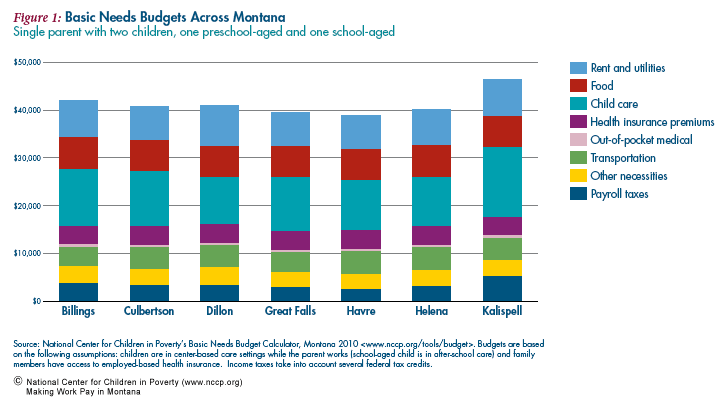
Across the seven localities examined in Montana, families need incomes of over twice the federal poverty level to cover their basic expenses of housing, food, transportation, health insurance, child care, and other necessities. Figure 1 shows that a single parent with two children, one preschool-aged and one school-aged, needs an annual income ranging from $39,000 in Havre to $46,000 in Kalispell to cover these expenses. This is equivalent to a wage of $19 to $22 per hour – two to three times the value of the minimum hourly wage of $7.35 and one and a half times the value of Montana’s median wage of $13.65.
In Montana, as in other states, a family’s largest expenses are housing and child care. Child care is the largest expense in all seven localities. For working families, this is a necessary expense that ensures children are well cared for while parents participate in the labor force. Additionally, high-quality child care – care that provides a stable, stimulating, developmentally appropriate, and positive emotional environment – promotes healthy child development. For low-income children in particular, high-quality child care helps to bridge the achievement gap between children from low-income and higher-income homes.
The budgets shown below include only the expenses most essential to supporting a family. They do not include other family expenses such as debt payments, spending on durable goods (such as furniture or appliances), or renter’s insurance. They also don’t allow for families to save money to provide a financial cushion in case of illness or family crisis or to build assets such as savings for a home, children’s education, or retirement. The budgets also do not cover enrichment activities or other expenses that improve a family’s quality of life. Families would need to earn more than these minimum budgets to make steps toward achieving long-term economic security.
Work Supports Can Help
For low wage workers, earnings alone do not provide enough income to cover the cost of basic expenses. Montana offers several “work support” programs that can help families fill the gap between earnings and basic expenses (Table 1). They include: Montana Best Beginnings Child Care Scholarship program, public health insurance such as Medicaid and Healthy Montana Kids, the Low Income Energy Assistance program (LIEAP), the Supplemental Nutrition Assistance Program (SNAP), and federal tax credits such as the Child Tax Credit, the Child and Dependent Care Credit, and the Earned Income Tax Credit (EITC). These programs support parental employment by supplementing income or reducing expenses while families transition to more stable jobs with higher wages. Work supports such as public health insurance and child care subsidies have also been associated with children’s healthy development and improved academic outcomes.
| Table 1: Work Support Policies in Montana (as of October 2010) | |||
| Work support program | Benefit | Income eligibility limits | Limits set at the national or state level |
| Child care subsidy program: BestBeginnings Child Care Scholarships | Child care subsidy | 150% FPL after subtracting deductionsfrom income | State |
| Supplemental Nutrition AssistanceProgram (SNAP) | Food subsidies (up to $526/month for a family of 3) | Montana uses broad-based categorical eligibility to expand eligibility to most households with gross incomes up to 200% FPL.
Montana waives the resource test. |
National, with somestate options |
| Section 8 Housing Choice Vouchers | Rental assistance | 50% of area median income | National |
| Low Income Energy Assistance Program (LIEAP) | Credit applied to heating bill Varies depending on region, dwelling type, number of bedrooms, and fuel type. (average benefit of $608 in FY 2010) | $4,980/year for a family of 3 aftersubtracting deductions from income | State |
| Temporary Assistance for Needy Families (TANF) Cash Assistance | Cash grants (up to $504/month for a family of 3) | 200% FPL | State |
| Public Health Insurance | |||
| Family Medicaid | Subsidized health insurance for parents and children | Parents and children:$13,968/year for a family of 3 beforesubtracting deductions from income$5,892/year for a family of 3 aftersubtracting deductions from income | State |
| Healthy Montana Kids Plus (formerly Children’s Medicaid) | Subsidized health insurance for children 133% FPL* after subtracting deductions | 133% FPL* after subtracting deductionsfrom income for children | State |
| Healthy Montana Kids(formerly CHIP) | Subsidized health insurance for children | 300% FPL* after subtracting deductionsfrom income | State |
| Federal Income Tax Credits | |||
| Federal Earned Income Tax Credit (EITC) | Refundable tax credit(up to $3,050/year for 1 child; up to$5,036/year for 2 children; up to $5,666/year for 3 or more children) | $35,535-$48,362 a year depending onfamily structure and number of children | National |
| Federal Child Tax Credit | Partially refundable tax credit (up to $1,000/year per child under age 17) | Gradually phases out to zero beginning at $75,000 or $110,000 a year, depending on filing status | National |
| Federal Child and Dependent Care Tax Credit | Nonrefundable tax refund (up to $1,050/year for 1 child; up to $2,100/year for 2 or more children) | No limit | National |
| As of January 2011, Montana has a state minimum wage of $7.35/hour (as compared to the federal minimum of $7.25/hour). *FPL: Federal poverty level in 2010 was $18,310 for a family of 3; $22,050 for a family of 4. |
|||
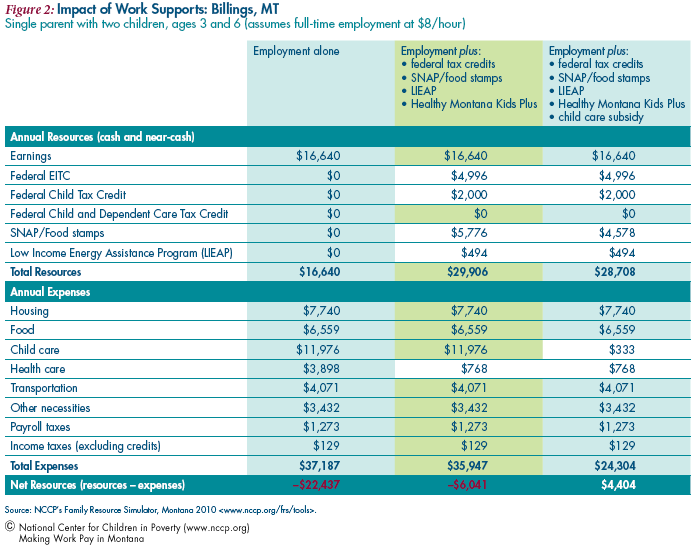
Figure 2 shows the impact of work supports on the resources and expenses of a single parent family with one pre-school aged and one schoolaged child in Billings. With employment alone, a parent working full time, year-round earning $8 an hour – $16,640 annually – faces a gap of over $22,000 between their annual expenses and resources. With the receipt of several work supports including federal tax credits, SNAP, LIEAP, and Healthy Montana Kids, the second column shows the family’s deficit is reduced to just over $6,000. The addition of a child care subsidy reduces the family’s highest expense making a crucial difference in helping the family make ends meet. Column three shows that the receipt of a child care subsidy along with other work supports reduces the family’s child care expenses from $11,976 to $333. The gap between income and expenses disappears, leaving the family with a small surplus of nearly $4,500, showing how a comprehensive package of work supports enables the family to make ends meet.
Despite the difference work supports can make in promoting economic security and healthy outcomes for children, many families do not access all of the programs for which they are eligible. A recent paper from the Urban Institute shows that nationally one in five eligible children do not participate in Medicaid or Children’s Health Insurance Programs (CHIP), nearly four in 10 eligible working households with children do not receive SNAP, and seven in 10 families eligible for child care subsidies are not served. These findings echo those of a previous study, which found that only five percent of low-income working families received a broad work support package of public health insurance, SNAP and a child care subsidy.
Several factors can contribute to limited program participation by families. Programs may have long waiting lists or inadequate funding that limit the number of families served. Burdensome application procedures that require in-person applications or confusing paperwork present barriers to many potential applicants. Other families do not know they or their children may be eligible or may avoid applying for programs that bear a social stigma. Additionally, onerous recertification processes may preclude families from retaining work supports. The upshot is that a substantial number of eligible, lowincome families, both nationally and in Montana, do not receive the work supports shown in Figure 2 to be critical to making ends meet.
The Cliff Effect in Montana
Although work supports are critical, the interaction of earnings, benefits, and expenses can have unintended consequences for families struggling to get ahead. Since eligibility for benefits is often means tested and based on income, increases in earnings do not always mean families are better off. For families who receive work supports, a “benefit cliff ” can occur, where a small increase in earnings leads to the complete loss of a work support, derailing their movement toward increased economic security.
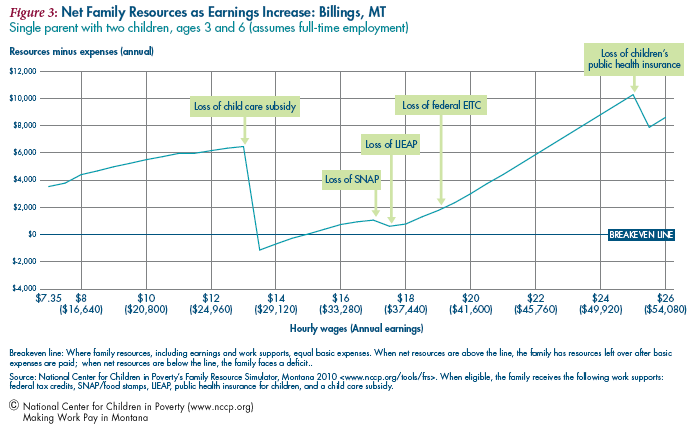
Figure 3 illustrates how benefit cliffs keep a single-parent family of three from getting ahead as earnings increase. It shows how net resources – total resources minus the cost of expenses – change as wages increase from Montana’s minimum wage of $7.35 to $26 an hour. This graph assumes the family receives federal tax credits, SNAP, LIEAP, public health insurance, and a child care subsidy when eligible. In practice, as previously noted, many families do not receive all the benefits for which they are eligible. Additionally, although federal tax credits are included in this package of work supports, they are not accessible year-round.
As the parent’s earnings increase, a succession of benefit losses keeps the family from gaining a secure economic footing. At $8.00 an hour, combined with work support benefits, the family is able to cover all their expenses and have a small surplus to pay off outstanding debt or put toward additional family expenses. The first and most significant benefit cliff occurs with the loss of the child care subsidy. As the parent’s wage increases from $13 to $13.50 an hour, income exceeds the child care program eligibility level of 150 percent of the federal poverty level and the family loses the subsidy. Having to pay market rates for child care causes their expenses to exceed their resources; consequently, their net resources fall below the breakeven line. As the family earnings increase, the loss of SNAP, LIEAP, and the federal EITC is experienced gradually and without a significant cliff because those benefits phase out gradually as earnings increase. At a wage of $22 an hour, the family’s net resources are at the same level as they were when earning $12 an hour. The family has finally recovered from the financial setback caused by the loss of the child care subsidy. But, despite nearly doubling their wage, the family has made little progress in achieving greater economic security. The final benefit cliff occurs with the loss of public health insurance for children and the increase in expenses when the parent must pay for employer-based family health insurance coverage. At this earnings level, the family is better able to meet the additional expense.
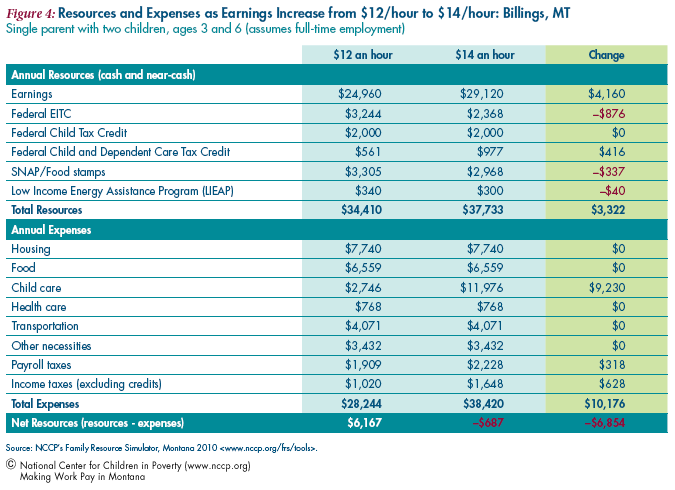
Figure 4 highlights the impact of the child care subsidy benefit cliff on the family’s resources and expenses as the parent’s wage increases from $12 to $14 an hour, illustrating how increases in earnings do not always translate into higher resource levels. Despite an earnings increase of $4,160, the family’s net resources fall by nearly $7,000 with the loss of the child care subsidy and reductions in the SNAP and LIEAP benefits. The family still receives support from federal tax credits, which continue to incentivize work and help offset job-related expenses for the family. Although the EITC phases out and the credit is reduced to $2,368, the family receives increased support from the child and dependent care credit. However, the increase in the child and dependent care credit coupled with the earnings increase is still not enough to counteract the loss of the child care subsidy. As a result, the family faces a deficit of $687 and is worse off than before their wage increase.
The situation illustrated in Figures 3 and 4 shows how the prospect of losing a work support can create disincentives to increase earnings. Families in these circumstances are confronted with tough decisions that can significantly impact their well-being. Passing up a wage increase can jeopardize eligibility for work supports as well as future promotions in the workplace. More affordable child care might provide lower-quality or less reliable care, potentially limiting the child’s development and the parent’s job security. A sound work support system would eliminate these difficult choices for working families, support advancement in the workforce, and ensure that when parents’ earnings increase, their families will be better off.
Variation Across Counties
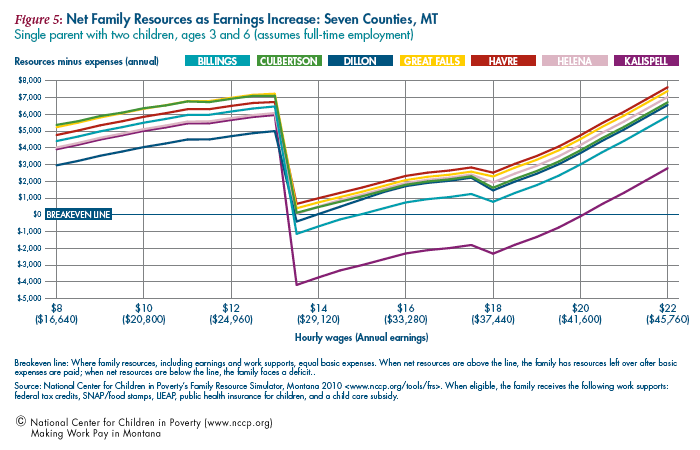
Across Montana, families face similar patterns of benefit cliffs but fare differently due to regional cost-of-living differences. Figure 5 shows net family resources for a single parent with two children in seven Montana counties. Eligibility rules and benefit levels for the work support programs examined in this brief are the same throughout Montana, with the exception that LIEAP benefits vary by county. A family of the same composition would lose work supports at similar income levels regardless of their residence location in the state. However, since expenses vary, families with the same earnings and work supports fare differently across the state. In Kalispell, which has the highest cost of living among the locations we examined in Montana, families who lose their child care subsidies at $13.50 per hour would not be able to make ends meet until they earned an income of nearly $20 an hour. In the localities with lower costs, families have higher net resources at each wage level and are able to get by after losing their child care subsidy well before reaching wages of $20 an hour.
Different Family Types
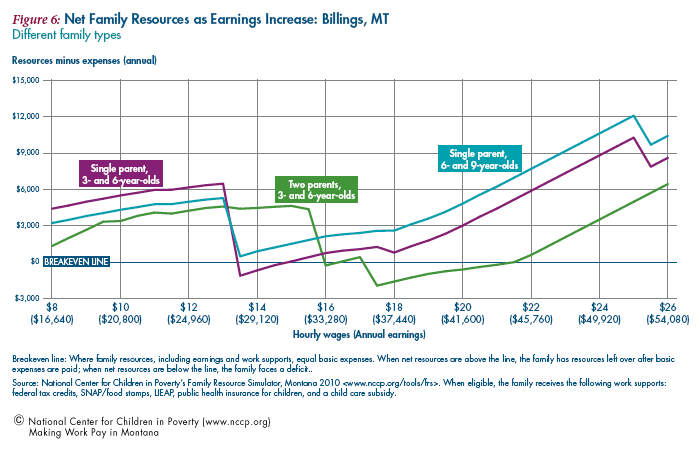
Figure 6 compares net resources as earnings increase for three differently composed families in Billings: a single parent with a 3-year-old and 6-year-old, a single parent with a 6-year-old and 9-year-old and a two-parent family with a 3-year-old and 6-year-old. As with the previous example, this scenario assumes that each family accesses all of the work supports for which it is eligible. The figure shows that among the three family types with young children, net resources at similar incomes differ while the pattern of resource cliffs across incomes is largely consistent for all family types.
For a single parent with two school-aged children, ages 6 and 9, the pattern of benefit losses is similar to that for a single parent with a 3- and 6-year-old (Figure 6). The family where both children are school age fares slightly better after losing the child care subsidy because neither child requires full-time care. At $27,000, after the loss of the child care benefit, this family is just able to meet expenses with their income and remaining work supports. At the same earnings level, the family with a younger child needing full-time child care faces a shortfall of about $1,000 a year.
Parental work patterns significantly affect jobrelated expenditures like child care and transportation. Two-parent families have greater discretion in choosing work and child care arrangements and expenses may vary more based on family circumstances. Without work supports, a two-parent family with one preschooler and one school-aged child and one working adult must earn $11 to $13 an hour, or $23,000 to $27,000 annually, to cover the family’s basic needs budget. In a similar family with two employed parents, each parent would need to earn $11 to $12 an hour to cover their augmented family budget with additional work-related expenses.
Figure 6 shows that two-parent families face challenges comparable to those of single-parent families as earnings increase. As the family transitions from one parent working outside the home and one parent foregoing paid employment to care for the children to both parents working full-time jobs, the family’s net resources hover around $4,000. Once the family hits the child care subsidy limit at around $33,000 in earnings, a large benefit cliff puts the family in the red. Despite both parents working full time, the increase in child care expenses leaves the family unable to cover their expenses even with the assistance of remaining work supports. While the family struggles to break even, they lose SNAP, LIEAP, and their federal EITC. The family eventually breaks even at $45,000 in annual earnings with the assistance of their only remaining work support, Healthy Montana Kids.
Improving Policies for Low Income Families
Across the United States, fiscal constraints are shifting state policy priorities toward basic preservation of work support programs. However, even as policy makers struggle to preserve the safety net for low-income and working families, they should continue to support strategies that improve the effectiveness of work support policies.
- Phase benefits out more gradually to soften or eliminate cliffs.
- Expand access to benefits by increasing eligibility limits and covering more eligible families.
- Coordinate program interactions, so that families do not lose multiple benefits at once.
In Montana the largest benefit cliff for families with children occurs with the loss of child care assistance. To address this cliff, the program’s income eligibility could be extended beyond 150 percent FPL. Gradually increasing family contributions as income climbs above 150 percent FPL would eliminate the current benefit cliff, stabilizing families’ child care arrangements and attachment to work. Policymakers might also consider linking income eligibility limits to regional cost-of-living variations.
Adopting a state earned income tax credit would enhance the resources of low- to moderate-income working families. The refundable federal Earned Income Tax Credit is considered one of the most successful anti-poverty initiatives in history, encouraging work by allowing families of modest means to keep more of their earnings. Since the eligibility limit for the EITC is higher than most work supports, it is particularly helpful for families whose incomes are too high to qualify for other work supports but too low to cover basic expenses. According to the Montana Budget and Policy Center, a state earned income tax credit has the potential to positively affect the income of 15 percent of working households in the state.
Montana has already adopted some program options that benefit low-income work support recipients. For example, by adopting SNAP’s expanded categorical eligibility, Montana expands access to SNAP benefits. However, more steps need to be taken to ensure work supports provide families with adequate resources and reward progress in the workforce. Using the strategies outlined above, policymakers can create a work support system designed to truly make work pay.
Endnotes
1. Based on NCCP’s analysis of 2009 American Community Survey.
2. Bureau of Labor Statistics. (April 6, 2010). May 2009 State Occupational Employment and Wage Estimates: Montana. In Bureau of Labor Statistics. Accessed Feb. 8, 2011, from www.bls.gov/oes/current/oes_mt.htm#00-0000.
3. Burchinal, M. R. Roberts, J. E. Riggins, Jr., R. Zeisel, S. A. Neebe, E. Bryant. (2000). Relating quality of center-based child care to early cognitive and language development longitudinally. Child Development, 71, 339–357. doi: 10.1111/1467-8624.00149
4. Caughy, M. O., DiPietro, J. A. and Strobino, D. M. (1994). Day-care participation as a protective factor in the cognitive development of low-income children. Child Development, 65, 457–471. doi: 10.1111/j.1467-8624.1994.tb00763.x
5. G. Mills, J. F. Compton, O. Golden. (2011). Assessing the evidence about work support benefits and low-income families. Urban Institute. Accessed Mar. 1, 2011, from www.urban.org/url.cfm?ID=412303.
6. S. Zedlewski, G. Adams, L. Dubay, G. Kenney. (2006). Is there a system supporting low-income working families? Urban Institute. Accessed Mar. 1, 2011, from www.urban.org/url.cfm?ID=311282.
7. Investing in Montana’s working families: A Montana earned income tax credit. 2011. Montana Budget and Policy Center. Accessed Apr. 14, 2011, from www.montanabudget.org/sites/default/files/reports/EITC%20Brief%20Final%20030711.pdf.
